The Wind Tower: An Architectural Marvel of Dubai
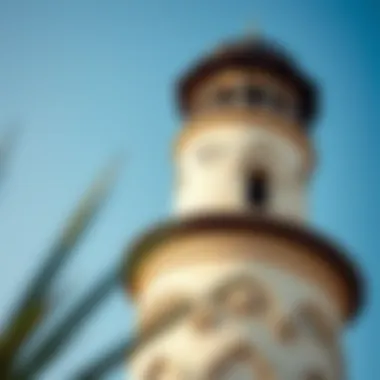
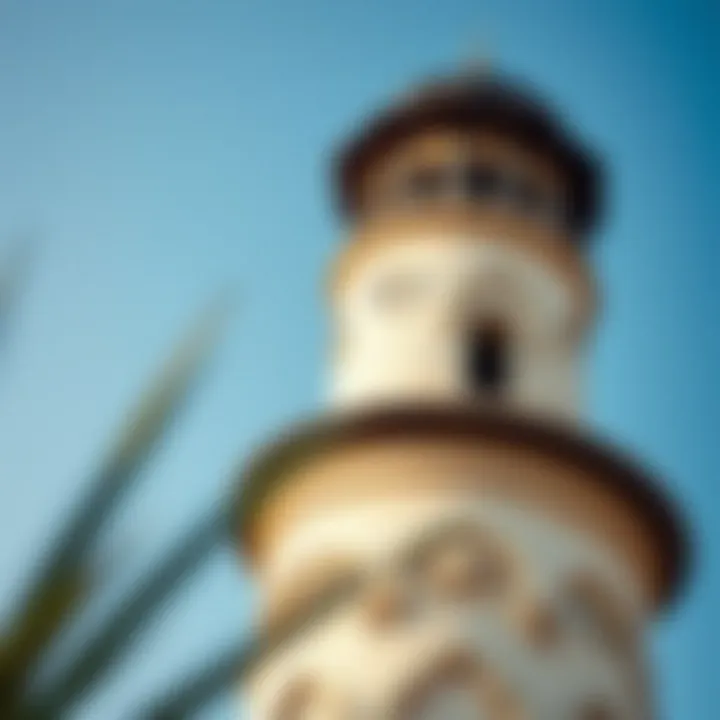
Intro
Dubai is a city that dances at the intersection of tradition and innovation, where architectural wonders seemingly sprout from the desert sands. One such marvel, the wind tower, stands proudly as a testament to the region's rich heritage while demonstrating an acute awareness of sustainable design. Wind towers, rooted in ancient Persian architecture, are more than just aesthetic structures; they are integral components that have defined the climate-responsive architecture of Dubai.
This article explores the significance of wind towers within Dubai's urban environment. We’ll delve deep into their historical origins, examining how they’ve evolved to meet contemporary design needs while upholding cultural values. As the real estate market in the Emirate undergoes rapid changes, we will discuss how these towers are not only architectural fixtures but also play a vital role in the sustainability narrative that the city is promoting.
From energy-efficient designs that naturally ventilate spaces to their contributions in preserving the local heritage, the conversation surrounding wind towers is multi-faceted and continuously relevant. As we look ahead, it’s essential to understand the implications these structures have on current market dynamics and future investment opportunities, particularly how they can guide sustainable practices in urban development.
Understanding Wind Towers
Wind towers, often referred to as badgirs in their traditional context, hold a unique place in the architectural heritage of the Middle East, especially in the bustling city of Dubai. Their structure not only enhances the aesthetic quality of a building but also serves a specific purpose that resonates with the region's climatic conditions. By understanding wind towers, one can appreciate how they merge functionality with tradition, exemplifying architectural ingenuity.
The significance of wind towers extends beyond mere ventilation; they symbolize a bridge between ancient wisdom and contemporary design practices. In the hot desert climate of the UAE, these towers capture cooler breezes, channeling them into the enclosed spaces below. This method of passive cooling is pivotal, allowing buildings to reduce reliance on mechanical air-conditioning systems. Emphasizing aspects like sustainability and energy efficiency, today's architects strive to retain the classic virtues of wind towers while integrating modern requirements.
Definition and Function
Wind towers are vertical structures that utilize natural airflow for cooling purposes. Typically built at a height that allows them to catch breezes, these towers draw air into buildings, promoting ventilation. The air enters through openings at the top of the tower and flows downwards, creating a cooler microclimate internally, which is particularly crucial during the extreme heat of the summer months. The design serves not only as a cooling strategy but also can enhance comfort levels within urban living spaces.
Historical Context
Origins in Persian Architecture
The art of building wind towers first emerged in ancient Persia, where they were ingeniously crafted to tackle the formidable heat of the region. The design is characterized by a vertical shaft open at the top, sometimes featuring a square or cylindrical shape, while their sides are often gracefully adorned. These structures represented a sustainable approach to architecture that took advantage of local climatic conditions.
What made them particularly beneficial was their ability to remain functional with limited materials. They required little energy and maintained a comfortable environment without the need for elaborate cooling systems. The unique feature of tall, tapered structures allowed for optimal airflow, making them not just effective, but also an enduring symbol of Persian ingenuity. Their craftsmanship has inspired modern variations and they remain relevant in architectural discussions today, especially in sustainability contexts.
Evolution through Time
Wind towers have undergone a fascinating evolution, adapting and transforming as they migrated beyond Persia into other regions, including the Arabian Peninsula. As architectural styles changed and urban environments began to modernize, so did the wind tower design. Advanced materials like reinforced concrete began to replace traditional adobe and mud brick, enabling architects to sculpt these structures into more contemporary forms.
Throughout this evolution, wind towers maintained their core function of ventilation but started exhibiting diverse styles that cater to varied architectural preferences. Techniques have also been developed to enhance performance, addressing issues such as dust accumulation that can hinder air quality. Furthermore, in today's context, there's growing interest in infusing technological advancements into the design of wind towers, which reflect both an appreciation for history as well as a commitment to modern energy practices.
By understanding the historical context and definition of wind towers, one can see how these structures are more than just functional pieces of architecture; they are an indispensable part of Dubai’s cultural identity and environmental strategy.
Architectural Style of Wind Towers
The architectural style of wind towers represents a blend of innovation and tradition that showcases Dubai’s rich cultural tapestry. It emphasizes both aesthetic beauty and functional efficiency, creating structures that are not only visually appealing but also integral to sustainable living in the desert. Wind towers serve as notable landmarks, reflecting a deep connection between the environment and the built form, while adapting to the needs of modern urban life.
Design Principles
Materials Used
When it comes to the materials utilized in constructing wind towers, the emphasis often falls on local availability and sustainability. Traditional wind towers were predominantly built using materials like limestone, which not only offer structural benefits but also help in temperature regulation. This stone is insulating, so it keeps interiors cooler during the scorching summers.
In modern constructions, you might see a combo of reinforced concrete and glass. The use of glass allows natural light to flood indoor spaces, reducing the need for artificial lighting. However, the reflective quality of modern materials can sometimes create an unpleasant heat trap, necessitating careful consideration in their use.
- Advantages: Natural insulation, reduced energy consumption.
- Disadvantages: Increased heat retention in modern materials.
Structural Integrity
The structural integrity of wind towers hinges on their ability to withstand harsh weather conditions while maintaining efficiency. A well-designed wind tower can endure strong winds and deliver enhanced airflow through strategic openings. Traditional designs often featured gracefully arched towers that not only provided structural strength but were also aesthetically pleasing.
Modern architects have incorporated advanced engineering techniques, ensuring that even the tallest towers retain stability. This leads to enhanced durability and a longer lifespan for the buildings, making them a smart investment in the rapidly evolving urban landscape of Dubai.
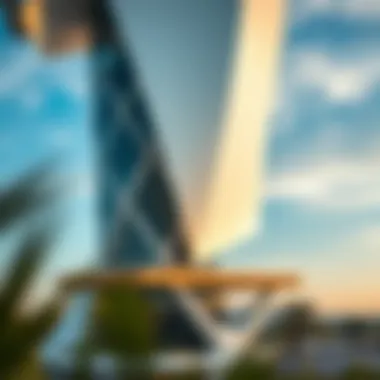
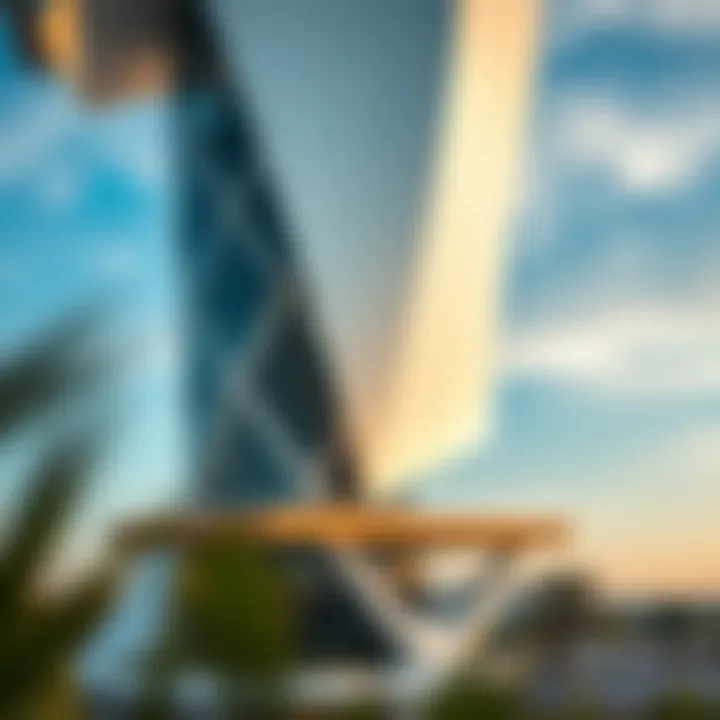
- Advantages: Stability against weather extremes, longevity of structures.
- Disadvantages: Potentially higher costs for advanced construction techniques.
Variations in Design
Traditional vs. Modern Designs
In discussing traditional versus modern designs, one notes how evolution has shaped wind towers over time. Traditional designs often incorporate exquisite hand carvings and local motifs, highlighting the region’s artistry and craftsmanship. These towers are typically more compact, crafted for efficiency, and are closely linked to lifestyle and culture.
Conversely, modern designs tend to push the boundaries of what a wind tower can be, utilizing new materials and technologies to create iconic structures that speak to the dynamism of Dubai's growth. They may feature taller towers with complex geometries that maximize airflow. Despite their differences, both designs underscore the importance of integrating cultural heritage into contemporary settings.
- Advantages: Preservation of cultural identity in traditional, innovative solutions in modern.
- Disadvantages: Risk of losing authenticity in modern adaptations.
Influence of Local Climate
The influence of local climate on the design of wind towers can’t be overstated. Dubai’s arid conditions necessitate structures that can harness the wind's cooling properties effectively. The ancient Persian wind towers were crafted to capture and direct breezes, cooling indoor spaces without relying on mechanical systems.
Modern architects have learned from these principles, designing towers with angled openings that funnel wind in such a way that it enhances natural ventilation. It’s a smart intersection of local climate adaptation and contemporary architectural vision, providing an eco-friendly alternative for temperature control within homes and businesses.
- Advantages: Effective natural cooling, energy savings.
- Disadvantages: Dependency on specific wind patterns.
Wind towers are not just buildings; they are integrated solutions responding to the unique desert environment, demonstrating the values of both heritage and modernity.
By understanding the architectural style of wind towers, we too can appreciate how these structures enhance not just the skyline of Dubai but also the sustainability efforts crucial for urban living. As we delve deeper into the cultural and functional significance, it becomes evident that these towers are vital in shaping Dubai's architectural identity.
Wind Towers in Contemporary Dubai
The incorporation of wind towers in Dubai's architecture marks a blend of the ancient and the ultra-modern. In a city where skyscrapers scrape the sky, the wind tower stands out as a beacon of historical ingenuity and future-oriented design. The significance of this architectural feature extends beyond mere aesthetics; it plays a vital role in energy efficiency and environmental sustainability in an urban landscape known for its scorching temperatures.
Integration with Modern Architecture
Case Studies of Recent Developments
Recent projects have showcased the graceful assimilation of wind towers into contemporary buildings. One prime example is the Al Bahar Towers, designed by the esteemed firm Aedas Architects. These twin skyscrapers integrate wind turbines within their facade, which allows for natural ventilation and significantly reduces reliance on air conditioning. This dual function is crucial to achieving an efficient and sustainable urban solution in a place like Dubai, where energy consumption is a major concern.
The defining characteristic of Al Bahar Towers is their responsive facade, which opens and closes, utilizing traditional wind tower principles while meeting modern design expectations. The advantage here is clear—this not only lessens energy consumption during hot months but creates a unique visual appeal amid Dubai's skyline.
Notable Projects Featuring Wind Towers
Another notable instance is the Diamonds Tower, which artfully employs wind towers alongside solar panels. This project emphasizes a commitment to sustainability, showcasing how architectural heritage can inform cutting-edge technology. The standout feature here is a sophisticated blend of passive and active design strategies, allowing it to maximize energy efficiency while also minimizing its environmental footprint.
Integrating these towers into contemporary projects makes for a smarter urban design, echoing Dubai's ambitious vision for the future. However, such complex designs come with challenges, including potential maintenance issues and the need for specialized materials that can withstand the harsh desert climate.
Sustainability and Energy Efficiency
Impact on Energy Consumption
Wind towers significantly influence energy consumption patterns in Dubai. By promoting natural ventilation, they reduce the dependency on mechanical cooling systems, which are notorious for driving up electricity bills and contributing to environmental degradation. A compelling feature is their ability to maintain comfortable indoor climates without substantial mechanical input. The integration of wind towers therefore represents a strategic approach to urban energy issues, catering efficiently to the challenges posed by the region's extreme temperatures.
Contributions to Urban Cooling
In terms of urban cooling, wind towers play an essential role in mitigating the urban heat island effect that often plagues cities like Dubai. They channel cooler breezes from above, efficiently dispersing heat accumulated in densely built environments. This is notable in projects like The Sustainable City, which employs wind towers to circulate air naturally, thus cooling community spaces without mechanical obstructions. Such applications highlight their importance in promoting ecological balance, offering a fresher alternative in a city where air conditioning typically reigns supreme.
Integrating wind towers in Dubai not only speaks to a rich architectural tradition but also fuels a vision of sustainability that every modern city should adopt.
In summary, the contemporary wind towers of Dubai illustrate an unyielding commitment to marry historical elegance with modern practicality. Whether enriching the skyline or reducing energy costs, their relevance grows in resonance with the city's drive toward sustainability. The integration of wind towers serves not only as a testament to architectural evolution but also as a key player in addressing climate challenges faced in urban environments.
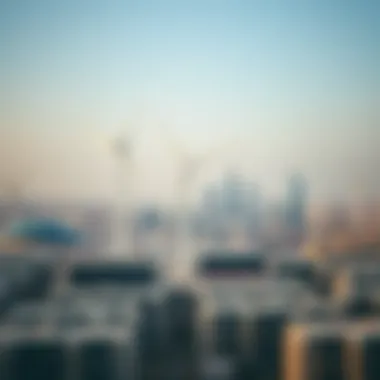
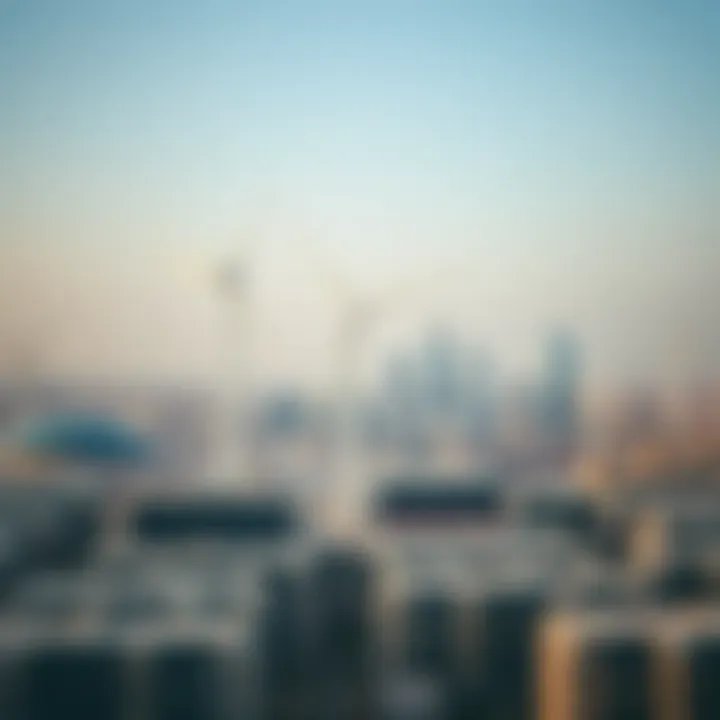
Cultural and Functional Significance
Wind towers are not just a mere architectural feature in Dubai; they embody the essence of the city’s cultural identity and serve several functional purposes that resonate even in today’s fast-paced urban environment. Understanding their significance helps to appreciate their role in harmonizing traditional and modern architecture, as well as their impact on sustainable living.
Cultural Heritage
Symbol of Dubai's Identity
The wind tower stands tall as a symbol of Dubai's identity, representing a unique blending of heritage and modernity. Built mainly from local materials like coral and limestone, these structures recall the city’s rich history while seamlessly integrating within a contemporary landscape.
What makes them particularly distinctive is their aesthetic appeal; the intricate geometrical designs are not simply decorative but a reflection of the region’s cultural norms and traditions. The incorporation of wind towers into new buildings highlights a commitment to preserving heritage amidst rapid development.
Their value extends beyond just beauty. As a beneficial choice for Dubai, wind towers resonate with the public’s desire for cultural connection, reminding residents and visitors of their roots in a place eternally transforming itself. However, as new constructions rise, the challenge remains in ensuring that these iconic elements aren’t overshadowed by glass-and-steel skyscrapers.
Connection to Community Living
Another significant aspect is the connection to community living that wind towers facilitate. These structures encourage open-air conversations, marketplace interactions, and community gatherings, which were essential aspects of life before air conditioning became commonplace. With local architecture aimed at nurturing social bonds, wind towers serve as a communal focal point that brings neighbors together.
This characteristic enhances social cohesion, making them an attractive feature in residential designs today. Despite the overwhelming concrete structures that often isolate urban dwellers, the air circulation offered by wind towers creates a more welcoming ambiance. However, in a bustling metropolis geared toward privacy, the potential downside is that not all new developments prioritize such open designs, risking the erosion of community ties.
Functional Advantages
Passive Cooling Concepts
When it comes to functional advantages, passive cooling concepts are perhaps the star of the show. Wind towers utilize natural airflows to keep living spaces cooler, dramatically lowering the internal temperatures without the reliance on mechanical systems. This indigenous knowledge respects both the environment and wallets, making life in the sweltering heat of Dubai a tad easier.
With air passing through the tower, hot air rises while cooler air is drawn down into the building, creating a natural airflow that reduces the need for conventional air conditioning. This practice leads to notable cost savings and promotes energy efficiency, making the wind tower a point of keen interest for sustainable architecture enthusiasts.
However, one must acknowledge that the effectiveness of these systems can vary based on building orientation and surrounding structures, presenting unique challenges in urban areas where tall buildings may interrupt airflows.
Reduction in Air Conditioning Needs
Lastly, the reduction in air conditioning needs is a substantial benefit stemming from the presence of wind towers. By contributing to the overall thermal comfort of a building, wind towers become a vital asset in establishing energy-efficient structures.
Encouraging passive cooling means less strain on electrical grids, particularly in periods of peak demand. It’s a smart investment for developers, who find that featuring wind towers can significantly cut operational costs related to cooling systems. However, it might be a little tricky to fully replace conventional systems in all types of buildings, given the climate extremes in Dubai.
In closing, the cultural and functional significance of wind towers extends far beyond their structural presence. They represent a harmonious balance between preserving history and advancing towards a more sustainable future. As Dubai progresses, the art of merging old with new will continue to define its unique skyline and foster community ties.
Challenges and Criticisms
The wind towers of Dubai, while celebrated for their innovative design and historical significance, face several challenges and criticisms. The discourse around modernization versus tradition, as well as maintenance and preservation issues, is vital, offering insight into the sustainability of these architectural gems in a transforming urban landscape. By unpacking these elements, one can grasp the delicate balance between the preservation of heritage and the pressures of contemporary urban demands.
Modernization vs. Tradition
Balancing Heritage Preservation
Preserving the essence of wind towers is essential in keeping Dubai's cultural identity intact. One crucial aspect of balancing heritage preservation lies in the careful restoration of historical structures, ensuring they retain their original aesthetic and functionality. This is particularly beneficial for attracting tourism and educating residents about their rich history.
A notable characteristic of this preservation approach is the use of traditional materials like limestone and mud, which not only reflect the architectural lineage but also serve as an eco-friendly alternative to modern construction resources. This commitment speaks volumes about the dedication to cultural integrity.
However, adhering strictly to traditional methods can be a double-edged sword. The unique feature is that while it sustains Dubai’s identity, it may hinder the integration of modern conveniences, such as energy-efficient technologies or structural modifications needed to meet today’s safety standards. Striking this balance is no easy task, yet it underscores how wind towers are both a nod to the past and a component of the future.
Adaptation to Contemporary Needs

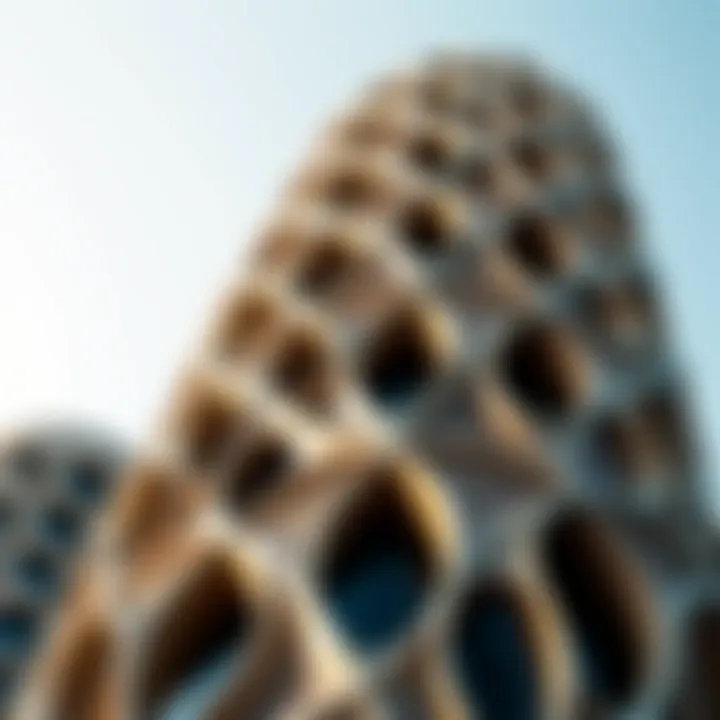
Adapting wind towers to meet contemporary needs is another significant challenge. Modernization often demands updates to these structures, accommodating advances in engineering and architecture. The main characteristic of this adaptation is the incorporation of advanced materials and techniques that enhance the building's performance under current environmental conditions, such as extreme heat.
This adaptation can be seen as a wise choice, allowing these iconic structures to remain functional and relevant. The unique feature here is the blend of old and new methods; for example, adding thermal insulation systems to prolong the effectiveness of passive cooling. However, this approach does raise concerns about diluting the traditional aesthetic that defines the wind towers' charm.
Maintenance and Preservation Issues
Longevity of Materials
A critical aspect of the wind towers is the longevity of materials used in their construction. Many of these towers were built using natural resources that, while visually appealing, may lack durability in the face of Dubai's harsh climate. This factor directly contributes to the overall resilience of the structures.
The key characteristic here is the choice of traditional materials which, while sustainable, require constant upkeep due to wear and tear over time. While some argue that newer materials could provide longer-lasting solutions, the charm of the wind towers hinges on their authenticity, presenting the perennial debate on which route is more beneficial for the structures’ survival.
Strategies for Conservation
Implementing effective strategies for conservation is paramount for the future of wind towers. One method involves regular inspections and maintenance, ensuring that any potential damage is addressed swiftly. Community initiatives aimed at raising awareness of the importance of these structures can also encourage local involvement in their preservation.
Highlighting the importance of these strategies stresses the need for a collaboration approach between architects, historians, and local authorities. The unique feature of these conservation efforts lies in engaging the community, promoting a sense of ownership and pride toward the wind towers. However, these strategies do require funding and resources that might often be scarce, compounding the issues around preservation.
"By striking a balance between modernization and heritage preservation, Dubai can maintain its architectural integrity while adapting to the needs of the present."
Overall, while challenges and criticisms abound regarding the wind towers, they fuel the ongoing conversation about the direction Dubai's urban landscape is heading. As discussions evolve, there’s a continuing hope that the rich heritage embodied in these structures will not only survive but thrive, reinforcing the city’s identity in the midst of rapid change.
Future of Wind Towers in Dubai
The exploration into the future of wind towers in Dubai showcases the ongoing evolution of a vital architectural legacy. As the city continues to grow and change, wind towers stand at the intersection of tradition and innovation. They represent not just a functional design choice, but also a cultural statement reflecting the values and aspirations of a modern metropolis. Understanding their future involves examining how emerging technologies can enhance their efficiency and the impact of cultural shifts in architecture.
Forecasting Future Trends
Emerging Technologies
Emerging technologies are at the forefront of transforming wind towers. Innovations such as solar panels integrated into wind towers are becoming more common, allowing these structures to generate energy while simultaneously providing cool air. This blend of functionality not only boosts sustainability but also reduces dependency on conventional power sources. Key characteristics of these technologies include automated sensors that adjust airflow based on temperature and the collection of data to enhance performance. This information leads to optimized internal conditions, making the wind towers not only energy efficient but also smarter. However, the adoption of such technologies can lead to high initial costs and the need for skilled labor for installation and maintenance, which raises questions about accessibility for all developers in Dubai.
"Embracing emerging technologies can redefine how we perceive traditional structures, making them essential players in the urban setting of tomorrow."
Cultural Shifts in Architecture
Cultural shifts in architecture also play a significant role in the evolution of wind towers. As the population in Dubai becomes more diverse, there is a growing emphasis on personalization in design. This means blending modern aesthetics with traditional motifs, thereby making wind towers not just functional but also visually appealing. The key characteristic here is adaptability. Buildings can be designed with flexible spaces that respond to the needs of the community. This unique feature reflects the aspirations of both local residents and expatriates, enhancing a sense of belonging and identity. Nonetheless, there’s a risk of diluting traditional aspects of wind towers by overemphasizing modern trends, which could confuse their historical significance.
Potential Investments and Developments
Investor Opportunities
As Dubai's interest in sustainable architecture grows, the potential investment opportunities in wind towers are expanding. Investors can find a lucrative niche in eco-friendly developments. With the rising demand for sustainable living, investing in energy-efficient structures allows them to tap into a forward-thinking market. The unique feature of these investments is the capacity for long-term revenue generation through reduced energy costs and increased property desirability. However, volatility in the market and changing regulations may pose challenges, ensuring that investors must stay informed about trends and shifts in policy.
Collaboration with Government Initiatives
Collaboration between developers and government initiatives continues to shape the future of wind towers. Government backing of green architecture fosters a supportive environment for projects in this area. An important characteristic of such collaboration is shared resources, including funding and technological assistance, which can lead to faster project completion and reduced costs. Government incentives for energy-efficient designs can also make wind towers an attractive option for developers. Despite the numerous benefits, these collaborations may be riddled with bureaucratic challenges and slow decision-making processes, potentially hindering progress.
The End
The importance of wind towers in Dubai's evolving architectural landscape cannot be overstated. As we draw this comprehensive exploration to a close, it's essential to reflect on why these structures remain not just relevant, but critical in today’s context. Wind towers epitomize a fusion of tradition and modernity, showcasing how age-old concepts can seamlessly mesh with contemporary demands.
The Timelessness of Wind Towers
Wind towers hark back to a time when architects were keenly aware of natural elements. This awareness has only grown more vital as urban centers swell and climate challenges become ever more pressing. They have become a symbol of sustainable architecture, blending function and aesthetic appeal into one.
Key Considerations:
- Cultural Significance: Wind towers embody a heritage that resonates with Dubai’s identity. They resonate not just with locals but with expatriates and investors seeking a connection to the region's cultural roots.
- Environmental Benefits: The cooling benefits they provide means less reliance on energy-consuming air conditioning systems. This results in a more sustainable urban environment, a crucial consideration in areas that experience extreme heat.
- Architectural Influence: These structures inspire a range of modern designs that incorporate eco-friendly practices while maintaining a nod to history. They encourage architects to think outside the box, marrying practicality with artistic expression.
- Investment Potential: Investors taking a long-term view will appreciate how these towers not only enhance property value but also represent a commitment to sustainable futures.
The compelling blend of form and function that wind towers offer isn’t just a remnant of history; it is a guiding factor that pushes forward the narrative of architectural innovation in Dubai. Observing the endurance of these structures within the swift pace of urbanization paints a hopeful picture for the city’s architectural future, an assurance that, despite the relentless march of modernity, some elements remain eternally revered.







